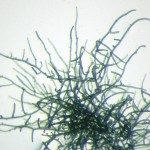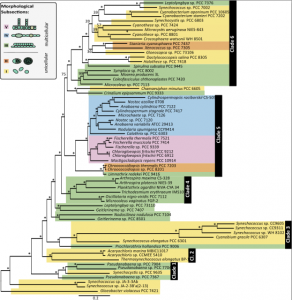Présentation
The PCC comprises more than 750 axenic strains isolated from very diverse habitats. The sequencing of the 16S rRNA of the majority of the PCC strains permitted to select reference strains for several genomic projects. For this, we choose from the PCC the strains representing at best the great breath in terms of morphology, ecology and physiology of the cyanobacterial phylum. We also examine their diversity in field and some of their physiological properties
We work at different scales:
- Transfer from Cyanobacteria to the Eukaryotic kingdom;
- Exchange and innovation within the phylum Cyanobacteria;
- Genetic homogeneity or disorder at the species level.
Recently, we demonstrated that the invention of oxygenic photosynthesis and the bestowal of photosynthetic lifestyle in this group of bacteria was transferred upon eukaryotes through endosymbiosis by more complicated evolutionary pathways than previously thought (Dagan et al., 2013) and their impact on the Great Oxydation Event (Schirrmeister et al., 2016). We also demonstrated that intracellular Ca-carbonate biomineralization is widespread in Cyanobacteria (Benzerara et al., 2014). Morevover, the comparison of 126 cyanobacterial genomes revealed the molecular basis for many aspects of cyanobacterial ecophysiological diversity, as well as the convergence of complex morphologies without the acquisition of novel proteins. This diversity-driven study with 54 new genomes allowed identifying more than 21,000 cyanobacterial proteins with no detectable similarity to known proteins. Given the exponentially growing number of sequenced genomes, this diversity-driven study demonstrates the perspective gained by comparing disparate yet related genomes in a phylum-wide context and the insights that are gained from it (Shih et al., 2013). The ultrastructure of these strains are also described in comparison with the genomic data (Gonzalez-Esquer et al., 2016).
We also investigate the genetic homogeneity or disorder at the species level. First, using the genomes of Microcystis, one of the most common toxic bloom-forming cyanobacteria in fresh waters worldwide, we explored the genomic basis of their ability to proliferate in varied environments. Our findings show that Microcystis genomes are characterized by having a large open pangenome, and around 11% of the genes seem to result from recent horizontal gene transfer events. We confirmed that all Microcystis genomes display a large genomic plasticity, which is characterized by a high proportion of repeat sequences and by low synteny values. Comparing to Prochlorococcus the dominant picocyanobacteria living in marine ecosystems, the Microcystis have almost opposite evolutionary strategies. However, both strategies have led to ecological success in their respective environments (Humbert et al., 2013). More recently, we investigated several genomes of Planktothrix, another successful toxic bloom-forming cyanobacteria in fresh waters worldwide (Pancrace et al., 2017). We confirmed that this genus is composed of planktic and benthic strains, which might posses a divergent repertoire for natural products.
Finally, field studies (in the frame of the French National Research Agency fundings through the research program ANR-08-CESA-015-04- ARISTOCYA, 2008–2012) or targeted investigation of performant bloom-forming cyanobacteria (in the frame of the French National Research Agency fundings through the research program ANR-15-CE34-0002- CYPHER, 2015–2018) indicate the risk asssement linked to cyanobacteria (Humbert et al., 2010). to better establish the evolution and risk assessment linked to cyanobacteria, we undertook the genome sequencing of all PCC strains at our disposal (Coll. with the Mutualized Platform for Microbiology).





